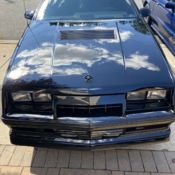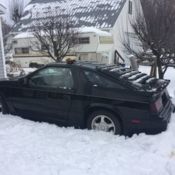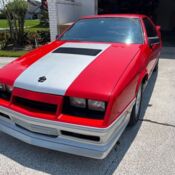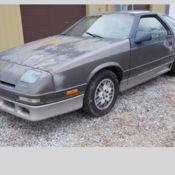1984 Dodge Daytona Turbo Hatchback 2-Door 2.2L
Price: -
Item location: Bogata, Texas, United States
Description:
1984 Dodge Daytona
http://www. hemmings. com/mus/stories/2006/02/01/hmn_feature15. html1984-'86 Dodge Daytona Turbo Z PreviousNext Feature Article from Hemmings Muscle Machines February. 2006 - George MattarOkay. we hear you laughing because there's a four-cylinder car on the pages of a muscle car magazine. But hold those letters folks. In 1984. while muscle was slowly returning from the grave. there weren't a heckuva lot of choices. You could buy a Monte Carlo SS or Camaro Z28. both with 180hp-and the Ford Mustang GT pranced around with 175hp. So. while things were improving over the late 1970s and early 1980s. things were pretty. well. ho hum. Over at Chrysler Corp. . which was coming off major reorganization after a federal bailout with Lee Iacocca at the helm. Dodge came out with the Daytona Turbo Z on October 1. 1983. and its sister car. the Chrysler Laser. which were introduced for the 1984 model year. While the GM and Ford cars all used carburetors. Chrysler delved into the world of multiport fuel injection and turbocharging for the first time. We still hear you laughing but. at the time. these cars were technological marvels. An "Electronic Navigator" and "Electronic Message Center with Voice Alert" were options that enhanced that claim. With prices of other Mopar muscle already out of the grasp of the common man and still climbing into the stratosphere. these wedge-shaped powerhouses offer a good alternative to the 440 and 426-powered B and E bodies. Even if it was a variant of the K-car on a shorter wheelbase. Chrysler engineers created the Daytona to draw youthful. performance-minded buyers into the fold. The Daytona Turbo Z achieved 22 mpg in town and up to 35 mpg on the highway. yet delivered decent performance for the money. As mentioned. the age of technology began in earnest and there were three high-tech devices in these cars. The Electronic Navigator was a comprehensive trip computer that used an LED display to share information with the driver. The time. day and date. fuel economy. both instant and average. amount of fuel used. amount of fuel remaining. range and estimated time of arrival were included. The Electronic Message Center was comprised of two informational systems. One was a dash-mounted pictogram that utilized illuminated icons to alert the driver of open doors. open hatch. low fuel and low washer fluid. Additionally. an Electronic Voice Alert acted as a backup. Electronic Voice Alert worked in conjunction with the message center and utilized a synthesized male voice to alert the driver of a dozen different potential maladies. Included were the now infamous: "A door is ajar. "Don't forget your keys. "Your electrical system is malfunctioning. "Your engine oil pressure is low" and "Your headlamps are on. " When all or any of these issues were corrected. the voice would politely say. "Thank you. " Engine The lone engine for the Daytona Turbo is the 2. 2-liter 142hp four-cylinder. This engine was nearly identical in 1984. 1985 and 1986. except for some minor horsepower differences and better electronics each year. This peppy engine produced 160-lbs. ft. of torque. The Garrett AiResearch turbocharger supplied 7. 5 pounds of boost at the 6. 00 rpm redline. Owners reported little turbo lag. and 0-60 times were in the 8-9-second range. The man responsible for this engine's development was Bernard Robertson. chief engineer of Chrysler's Powertrain Systems Engineering. The Turbo Z engine traditionally needed more maintenance than normally aspirated versions. but the 2. 2 engine is pretty solid. However. they were economy cars and many external accessories. particularly air conditioning compressors. had short life spans. The early Turbo Zs were considered throwaway cars by some. so the engines are plentiful in junkyards. One recall in 1985 centered around a fuel hose routed to the fuel-system pressure regulator which may have had a loose hose clamp. In 1986. a recall warned that fuel leakage may have occurred in low ambient temperature operation where a fuel supply hose connected to the pressure regulator in the engine compartment. Timing belts should be replaced per Chrysler recommendations. (The cylinder head itself is strong and the valves won't bend if the belt breaks. but to avoid any problems. change the timing belt. ) Owners also report wiring can be troublesome. One of the biggest problems is head gasket failure. particularly on cars which had the turbo boost modified. The 1984 models used a one-year-only turbo design. In 1985. the turbo and its electronics were much improved. The 1984-1986 Turbo Zs were not intercooled from the factory. The first intercooled engines appeared in 1987. Transmissions Buyers could choose between the standard-issue five-speed manual transmission or a Chrysler-built A-413 automatic transmission. The manual box had ratios of: first. 3. 29:1; second. 2. 08:1; third. 1. 45:1; fourth. 1. 04:1 and fifth. 0. 72:1. Reverse was 3. 14:1. The three-speed automatic had gear ratios of: 2. 69:1. 1. 55:1 and 1. 00:1 in first through third gears; reverse was 2. 10:1. While certainly not having the anvil-like durability of Chrysler A-833 manuals and TorqueFlites of the past. these transmissions held their own. Many Chrysler automatics of this vintage are problematic and most. if not all. have been overhauled. Differential Like all front-wheel drivers. this car used drive shafts bolted to a knuckle at the end of the shaft on each side. The standard final-drive ratio on the Daytona was 2. 57:1 with a five-speed manual and 3. 22:1 or 3. 02:1 with the automatic transmission. All parts needed to rebuild the differential are available. Suspension & Brakes The standard braking system had front disc and rear drum brakes. The front suspension had Iso-struts and an anti-roll bar. Out back. there was a rigid rear axle with radius arms and a track bar. There was an optional handling package which included Goodyear Eagle GT P195/60R15 tires on the unforgettable "Swiss-Cheese" wheels. higher spring rates. better stabilizer bars/bushings. gas-filled struts and shocks. along with progressive jounce bumpers. In 1986. a C/S (Carroll Shelby Competition Series) package was introduced as an option on the Turbo Z model. Shelby himself was not directly involved in the design but some still rated it "Porsche-like. due to a 220-pound weight loss and Dodge's "Maximum Performance" suspension package. which sold for $183 and included: performance gas shocks/struts; a 32mm front anti-roll bar (in contrast to the stock 27 mm piece) and a solid 28mm rear bar; and bigger "Crab" wheels. which were 6. 5 inches wide. with 225/50VR-15 Goodyear Gatorback tires. The CS cars offered a large improvement over the standard suspension. At higher speeds. the rigid rear axle tended to make the rear end very light and hard to control (about 61/39-percent weight distribution depending on engine). The Daytona's chassis was never updated from 1984 and is plagued by lack of rigidity. Steering is generally good and. in fact. a later version of this system was used in developing the Plymouth Prowler. Wheels & Tires The standard tire on the Daytona model was P185/70R14. Aluminum wheels were optional. and raised white-letter tires were available only on the regular Turbo model. When the "Maximum Performance" package was ordered. the Daytona was delivered with 225/50VR-15 Goodyear Gatorback tires. The "Swiss Cheese" wheels were available only in 1984 with four lugs and shod with P195/60-15 tires. In 1985. these were replaced with the five-lug "pizza" wheels and had larger P205/60-15 tires. Chassis The chassis utilized a unibody platform and rode on a 97-inch wheelbase. Overall height measured 50. 3 inches and the width of a Turbo Z was 69. 3 inches. The front and rear track measured 57. 6 inches and 57. 2 inches respectively. Body The body used Chrysler's unibody construction and the panels were all steel with rubber-covered bumpers fore and aft. The 1986 C/S version is hard to identify as there were only very small CS badges on the fenders behind the front wheels. There are several recalls that Chrysler issued over this three-year period and notables include the hood latch system. which had integrity problems; the hood may open in motion on 1984 models. Body and trim pieces. especially those Turbo Z-specific. are the toughest to find. Since the car's air fence sits only three inches above the ground. these parts are destroyed first. The hardest part to find in good shape is the air fence. Two side skirts ride along the rocker panels as part of the aerodynamic package. When buying a Turbo Z. look for rust. especially in snow-belt cars. The door hinges tend to fail as the doors are very heavy. Hard-to-find items include T-top weatherstripping. bumper covers. spoilers and the front air fence which was unique to Turbo Zs. These cars tend to squeak and rattle with age. and although that alone isn't necessarily an indication of a car with poor body integrity. a lot of noise could be a warning sign. The fuel tank had a 14-gallon capacity. T-tops became available in 1985. and by 1986 were fairly common. Interior The standard interior included bucket seats. but there were numerous options. such as leather seating surfaces. T-tops. power windows and power door locks. One potential problem in 1985 involved the driver's seat frame. which could have experienced a weak point at one of its four attachment points (the front/outboard portion) and was the subject of a factory recall. Reproduction Parts Parts still available from Chrysler include window seals. door seals. window sweepers. side reflectors. but mostly mechanical parts. There are plenty of aftermarket parts available for Turbo Zs. particularly engine parts. After 20 years. factory replacement parts for the interior and body are getting quite thin. Owners report some Chrysler parts are still available and many would think they were discontinued long ago. Performance Parts The first thing most people do to modify their cars is install intercoolers. larger fuel injectors and a reprogrammed computer to allow for higher turbo boost levels. Other ways to increase the power of your Turbo Z is to install a high-flow exhaust. intake. high-flow air cleaner and a new or bigger turbocharger. You'll also want to install high-performance spark plug wires and a newer distributor. If you are thinking big-block power. you can convert to rear-wheel drive. which is quite an undertaking. But Mopar Performance offers a rear-wheel-drive conversion kit (P4529533) and a 4. 5-inch bolt circle steering-knuckle kit (P4529329). Chrysler still has numerous engine parts available for these engines. The best way to shop is to get a book entitled 2. 2/2. 5 FWD Speed Secrets and Racing Modifications. Other good sources are Forward Motion and Lambros Race Engineering. Chassis Upgrades One of the biggest issues is bump steer. which can be eliminated with rack spacers. You also can reduce the anti-roll bar's binding by either running a Quickor end link bar or running a custom unit that is mounted to the front core support. If you want to upgrade the rear suspension. one of the best is a De Dion modified solid axle setup. Owner's View Aaron Kahlenberg. a 37-year-old teacher from Valley Village. California. owns our feature Daytona Turbo Z. "This 1985 Dodge Daytona Turbo Z was purchased from its original owner in Del Rey Beach. Florida. The owner. Frances Vissing. was the wife of a prominent Dodge dealership owner in Jeffersonville. Indiana. Mr. Vissing ordered this fully loaded (except sunroof) car for his wife as a retirement gift. Within months of taking delivery. Mrs. Vissing (in her Turbo Z) and her husband (in a Dodge Aries wagon) took off to Florida for retirement. Now in her mid-80s. Mrs. Vissing stopped driving when the car had 35. 00 miles. " Aaron's wife bought this car for him as a third anniversary present. "She knew how badly I wanted one since I was 14. I like the fact that it brings back good memories. I also like that Daytona Turbo Zs are unique in today's collector car market since most were hauled off to junkyards. " Values 1984-'86 Dodge Daytona Turbo Z Year: 1984 Low: $1. 00 Average: $3. 00 High: $5. 00 Year: 1985 Low: $2. 00 Average: $3. 00 High: $5. 00 Year: 1986 Low: $2. 00 Average: $4. 00 High: $5. 00 Parts Prices Anodized-aluminum fuel rail$125Brake proportioning valve$85Charge air temperature sensor$29Cylinder head. performance$950Distributor cap (OEM)$10Engine gasket kit (Dana Victor)$111O2 sensor. four-wire (OEM)$68Knock sensor (OEM)$37MAP sensor$75Radiator (Modine)$80Strut tower bars$85Fuel pump. high-pressure in-tank$118Catalytic converter$65Exhaust donut. 2. 5-inch$14Injector (Echlin)$32Spark plug wire set. standard$15Combo TU 3-inch Swingvalve and 3-inch downpipe$300Spark plug (Autolite) cooler range than OEM$8 eachWater pump (Airtex)$20Torque converter. race$600Torque converter. street performance$300Club Scene The WPC Club. Inc. Box 3504 Kalmazoo. Michigan 49003-3504www. chryslerclub. org Dues: $30/year; Membership: 4. 00 Shelby Dodge Auto Club PO Box 3759 Centerline. Michigan 48015www. sdac. org 586-759-6160 Dues: $30/year; Membership: 400Vehicle Details:
- Make: Dodge
- Model: Daytona
- Type: Hatchback
- Trim: Turbo Hatchback 2-Door
- Year: 1984
- Mileage: 32,054
- VIN: 1b3ba64e5eg290072
- Color: Red
- Engine size: 2.2L 135Cu. In. l4 GAS SOHC Turbocharged
- Number of cylinders: 4
- Power options: Air Conditioning, Cruise Control, Power Windows, Power Seats
- Fuel: Gasoline
- Transmission: Automatic
- Drive type: FWD
- Interior color: Black
- Options: Sunroof, Cassette Player, Leather Seats
- Vehicle Title: Clear Want to buy? Contact seller!






